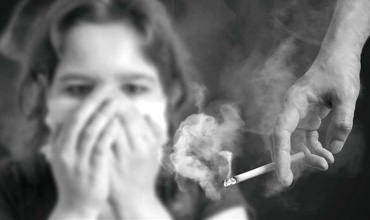Passive Smoking and its Effects among Children of a Rural Population in South Tamilnadu, India

Abstract:
Tobacco kills nearly 6 million people each year. Passive
smoking is a major hazard to the health of millions of children worldwide.
Globally, an estimated 40% of children are reported to be exposed to passive
smoke. Adverse effects of smoking in
rural population are well studied in any parts the world. But the impact of
passive smoking on the children is not widely studied.
Objectives: This study was carried out with
the following two objectives: 1) To determine the prevalence of
passive smoking among children in a rural population in South India and 2) To
find out the effects of passive smoking on children in the study population.
Methodology: This is a
community based cross sectional study. It was carried out in Marappadi village
in Kulasekharam Panchayat, Kanyakumari District, Tamilnadu in October 2014. 150
children under 15 years in the village were approached at their houses, with
questionnaire for socio demographic details and passive smoking history. Apart
from this the history of Low birth weight, Growth retardation, and number of
URTIs, LRTIs, Ear Infections, Allergy and Asthma episodes were elicited. Data
collected was entered in Excel spreadsheet and Analysis was done using SPSS
version 16.
Results: There were 150
under 15 children in the study which were collected from 96 households. They
were 82 (54.7%) males and 68 (45.3%) females. Passive smoking was present in 32
(21.3%) children. Overcrowding was present in 61 (40.7%) children’s houses. 64
(42.7%) children didn’t have adequate ventilation. Smoke from kitchen was
present in 126 (84.0%) houses. 40 (26.7%) of the households were having anti
mosquito usage in their house. The number of URTIs was significantly more with
children having history of passive smoking as denoted by significant p- value
is 0.002. Asthma was present in 20 (13.3%) of children; ear infection was there
in 6 (4.0%) children and Allergy was present in 18 (12.0%) children at the time
of study. They were more with children having history of passive smoking by
looking at the simple percentages. But they were not statistically significant
(p – value > 0.05).
Conclusion: 1) The
prevalence of Passive Smoking in the study population is 21.3%. 2) Environmental
risk factors like Overcrowding, Lack of adequate ventilation, Smoke from
kitchen and Anti Mosquito smoke are significantly more associated with children
having Passive Smoking. 3) Upper Respiratory Infections are more significantly
associated with those who have history of Passive Smoking.
Keywords: Passive Smoking, Rural Population, Smoking among Children, Smoking
complications, Rural India.
References:
[1.] ASH Research Report – March
2014:Secondhand Smoke: the impact on children. Available for download from: http://www.ash.org.uk/files/documents/ASH_596.pdf
[2.] Abolhassan Seyedzadeh, Forough Hashemi,
Akram Soleimani. Relationship between Blood Pressure and Passive Smoking in Elementary
School Children. Iranian Journal of Pediatrics,
Volume 22(Number 3), September 2012, Pages: 351-356.
[3.] Amany Abdel-Fattah El-Shazly, Walid Mohamed
Abd El Raouf El-Zawahry, Ahmad Mohamed Hamdy, Manal Basyouni Ahmed. Passive Smoking
as a Risk Factor of Dry Eye in Children. Journal of Ophthalmology Volume 2012, Article
ID 130159, 5 pages. doi:10.1155/2012/130159.
[4.] Burke H, Leonardi-Bee J, Hashim A, Pine-Abata
H, Chen Y, Cook DG, et al. Prenatal and Passive Smoke Exposure and Incidence of
Asthma and Wheeze: Systematic Review and Meta analysis. Pediatrics. 2012;129(4):735-44.
[5.] Centre for Community Child Health 2006. Preventing Passive Smoking Effects On Children Practice. Available for download from:
http://www.rch.org.au/uploadedFiles/Main/
Content/ccch/PR_Smoke_Effects_S2.pdf.
[6.] D Gupta, AN Aggarwal,
SK Jindal. Pulmonary effects of passive smoking: the Indian experience. Tobacco Induced Diseases 2002,
1:129-136 doi:10.1186/1617-9625-1-2-129.
[7.] Giorgos S. Metsios, Andreas D. Flouris,
Manuela Angioi, Yiannis Koutedakis1. Passive Smoking and the Development of Cardiovascular
Disease in Children: A Systematic Review. Cardiology Research and Practice. Volume
2011, Article ID 587650, 6 pages. doi:10.4061/2011/587650.
[8.] Gupta D, Aggarwal AN, Kumar R, Jindal
SK. Prevalence of Bronchial asthma and association with environmental tobacco smoke
exposure in adolescent school children in Chandigarh, North India. Journal of Asthma 2001, 38:501-507.
[9.] Jyoti Sanghvi, Ravindra Kumar, Mithun
Somani. Effectiveness of Discontinuation of Passive Smoking on Lung Function of
Children by Peak Expiratory Flow Rate (PEFR).
Int. J. Bioassays, 2013, 02 (11), 1457-1461.
[10.] Laura L Jones, Ahmed Hashim, Tricia McKeever,
Derek G Cook, John Britton, Jo Leonardi-Bee. Parental and household smoking and
the increased risk of bronchitis, bronchiolitis and other lower respiratory infections
in infancy: systematic review and meta-analysis. Respiratory Research 2011 12:5.
[11.] Novaily Zuliartha, Ridwan M. Daulay,
Melda Deliana, Wisman Dalimunthe, Rini Savitri Daulay. Association between passive smoking and Mycobacterium
tuberculosis infection in children with household TB contact. Paediatr Indones, Vol. 55, No. 1, January
2015. Pages 29-34.
[12.] Royal College of Physicians. Passive
smoking and children. A report of the Tobacco Advisory Group of the Royal College
of Physicians. London: Royal College of Physicians; 2010.
[13.] Regina M. V. Gonçalves-Silva, Joaquim
G. Valente, Márcia G. F. Lemos-Santos, Rosely Sichieri. Household smoking and respiratory
disease in under-five children. Cad. Saúde Pública [online]. 2006, vol.22, n.3,
pp. 579-586.
[14.] The Global Adult Tobacco Survey (GATS)
India, 2009-2010. Ministry of Health and Family Welfare 2010, Government of India,
New Delhi. Available for download at: http://mohfw.nic.in/WriteReadData/l892s/1455618937GATS%20India.pdf
[15.] U.S. Department of Health and Human Services. Let’s Make the Next Generation Tobacco-Free: Your Guide to the 50th Anniversary Surgeon General’s Report on Smoking and Health. Available for download at: http://www.surgeongeneral.gov/library/reports/50-years-of-progress/consumer-guide.pdf
[16.] Vork K, Broadwin R, Blaisdell R. Developing asthma in childhood from exposure to secondhand tobacco smoke. Health Perspect. 2007;115(10):1394-400.

